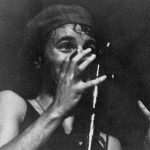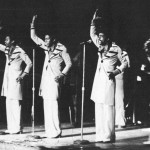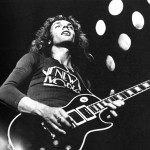Hard-rocking in the Heavy Seventies
Old and young, rising stars and fabled legends, jazzbos, rockers, and troubadours—all sorts of performers left their mark on the students of Trenton State in the 1970s.
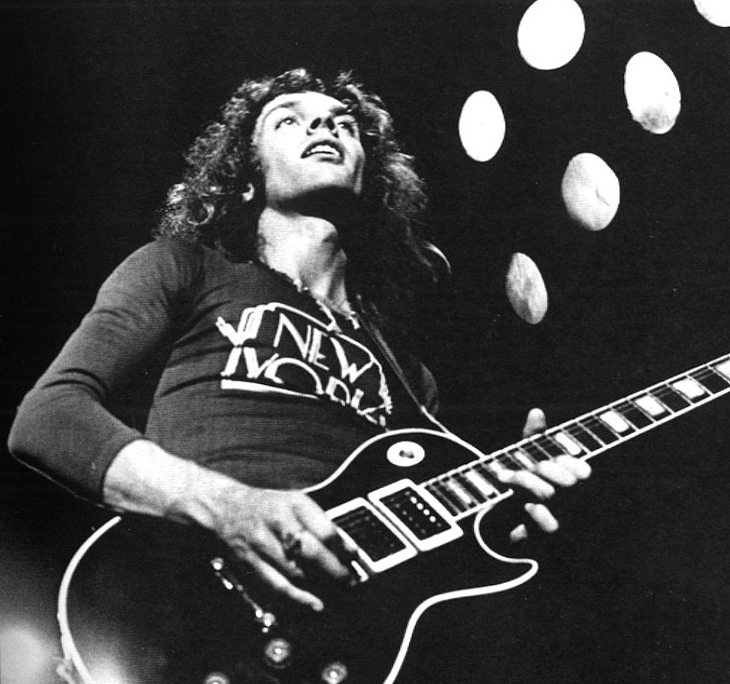
Peter Frampton came alive on campus on February 13, 1976.
In the autumn of 1973, a newsy cap-wearing Jersey boy was about to turn the tables on Kendall Hall.
Opening for Brian Auger and his ominously named Oblivion Express, a young Bruce Springsteen and his band ran through some of his first big tunes, like “Spirit in the Night” and “The E Street Shuffle,” and did a couple of things that Mike Butkus ’76 had never seen before.
Butkus and his rocker friends were impressed with the way Springsteen wove stories about girls and the boardwalk into his set, and bewildered when the E Street Band brought out a tuba.
“He was one of those unusual people,” said the former photographer for The Signal and The Seal.
Halfway through the Oblivion Express, students began slipping out: “Bruce Springsteen stole the show,” the 1973 Seal recalled.
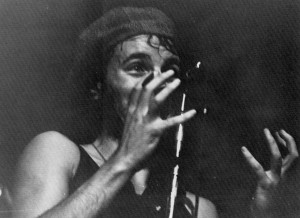
Butkus wasn’t very surprised when, after the release of Born to Run in 1975, Springsteen’s career took off. The songwriter took his time with the TSC audience and encouraged participation. “You could tell he liked what he was doing.”
That opening slot was The Boss’ last gig at the College, but he wasn’t the only big name to take the stages of Kendall Hall and the Rhodora Theatre.
Later that same year, Electric Light Orchestra wowed students, performing with jazz-fusion openers, Chick Corea and the Return to Forever. A Signal reviewer wasn’t a fan of ELO’s vocals, but he praised the band’s cello-tinged impact, calling the show “one whale of a musical display that Trenton State College will have to wait many a moon to see matched.”
Throughout the decade, the College brought in a diverse stock of whale-sized acts; between the hot chart-toppers, the avant-garde head-scratchers and the thoughtful singer-songwriters, it’s not easy to sum up the campus concert scene in the 1970s. But one thing was pretty consistent, according to Butkus: “[The shows] were always packed … it was the thing to do.”
***
On concert weekends, TSC’s saloon door swung: Commuting students abandoned campus on Friday afternoons, Butkus said, only to flock back to school for Saturday show times.
Greg Caiola ’79, a former WTSR station manager, attested to the diversity of the musical offerings, recalling performances by Blood Sweat & Tears (“the horn section was amazing”), proto-rap guru Gil Scott-Heron (“some of his stuff is not for the faint of heart”), and even a rising Tom Waits, who played in the newly opened Rathskeller.
“It was so damn cheap it’s almost a sin,” said Caiola, who returned to his alma mater last year in the role of director of corporate and foundation relations. A few dollars bought students the chance to see nationally known acts—as well as less known but remarkably talented ones—who often stopped at the College on their way to Philadelphia or New York.
Folk, soul, jazz, classical, rock, pop, and fusion were all welcome. “There was never a shortage of good music on campus,” Caiola said.
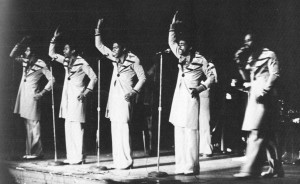
The pages of 1970s yearbooks capture a festival billing’s worth of stars: Steppenwolf visited in 1970; The Byrds and Seals & Crofts in 1971; blues legend John Lee Hooker and jazz great Duke Ellington in 1973; Billy Joel, the piano man, in 1974; Peter Frampton in 1976; The Kinks in 1977; and The J. Geils Band in 1979.
And that list, in many ways, only scratches the surface.
The Signal poked fun at the tidal wave of gushing over Peter Frampton when the guitarist and singer played Kendall Hall. At the show, a reporter said, “He was confronted by at least two dozen musically aroused women.” The highlight of the night? “Either the introduction of a ‘voice box’ into his repertoire or the unsnapping of his skin tight stretch pants—depending on your sexual persuasion.”
But Frampton wasn’t the only one stealing hearts. The student newspaper gave singer-songwriter Janis Ian a loving review after her 1974 show at the Rhodora. “I saw a love poem Monday night … her name is Janis Ian and she’s not much bigger than the Martin guitar that hung from her shoulders,” it read.
Students rubbed elbows with rockstars. Michael Silance ’77 ran into Billy Joel before a Friday night show. “I met him and some of his band members that afternoon … it was a cold snowy day and I was in the ‘Old Pub’ back then,” Silance recalled.
Joe Howarth ’78 worked the concerts—moving equipment and overseeing the stage and performer areas—for $2.25 an hour. He met Frampton and Al Stewart through his stage gig, but he didn’t make too much of the encounter, he said. “They were just pretty cool people.”
Theresa Martinac ’72, MEd ’73, a former CUB director and a current executive board member of the Alumni Association, remembered a moment of star-shock. She was on her way to retrieve the check for the retro group Sha Na Na, which she booked for Fall Weekend. “I’m coming back, (and) standing outside Packer Hall is this guy in jeans and a white T-shirt.” The greaser she bumped into, she eventually realized, was one of the singers.
Sha Na Na was only her favorite of a number of fondly remembered performances which, she said, took place at a significant point in music—the transition from psychedelic rock and bubblegum pop to the grander, still more diversified sounds at the turn of the decade. “There was still some of the message…but you were getting into a whole other area of music.”
***
Nearly every show, it seems, had its quirks. Billy Joel, who ended up playing the entirety of his Piano Man album, arrived more than an hour late due to a snowstorm, and he thanked the College students for their patience. Organizers screened Reefer Madness in between sets. The Charlie Daniels Band, which gave an otherwise great performance, left students’ ears ringing for days. Patti LaBelle played “madam” as her female cohorts “propositioned” members of the crowd during LaBelle’s hit, “Lady Marmalade.”
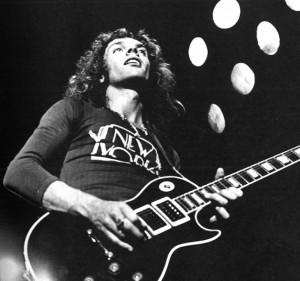
There were scores of mention-worthy performers that have faded from mainstream memory—they include innumerable folk artists, organist Virgil Fox, and jazz-guitar star John McLaughlin with his Mahavishnu Orchestra. Renaissance, the English prog-rock band, gave what Caiola called “as perfect a concert as I’ve ever seen.”
But everyone can hang their hats on the heavy-hitters.
The Kinks were well-seasoned rock stars when they “Konquered Kendall” in 1977, as The Signal wrote. The students cheered “L-O-L-A” along with frontman Ray Davies on “Lola,” and the singer emerged for an encore dressed as Santa Claus, a nod to the band’s edgy holiday single, “Father Christmas.”
But the music still resonated with the students in the audience, most of whom were children when the band broke in the U.S. with “You Really Got Me.” On “Schooldays,” Davies sang, “Now I wish I hadn’t strayed/And I’d go back if I could only find a way.”
“He still maintains his appeal to the common, everyday young person,” a student reviewer wrote.
The students seemed equally enthralled by the musical elders: A Seal spread on Duke Ellington’s concert thanked the bandleader for his appearance. “His boundless smile and endless talent did more to say love than a thousand words, yet no one would say that Duke is short on words,” the yearbook said. The 1973 performance would be one of Sir Duke’s last; he passed away the next year.
Old and young, rising stars and fabled legends, jazzbos, rockers, and troubadours—all sorts of performers left their mark on the students of Trenton State in the 1970s.
For Martinac, the concerts she saw as a college student are classic cases of I-saw-them-when. It’s a treat, she said, to be able to look back and say, “Wow, wait a minute.” Somewhere along the crossroads of pop music history, that all really happened.
- Bruce Springsteen during his November 11, 1973 concert on campus.
- Kool and the Gang during a November 2, 1973, concert on campus.
- Peter Frampton came alive on campus on February 13, 1976.
Posted on June 10, 2012


